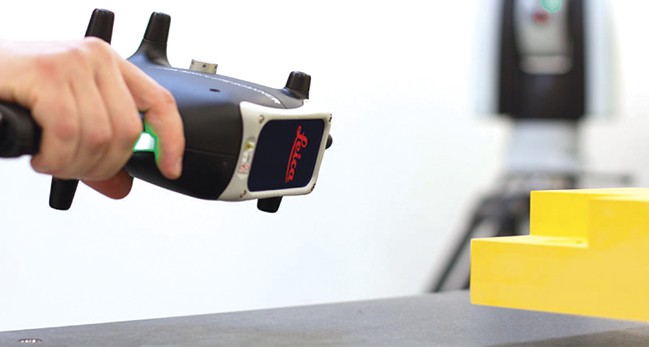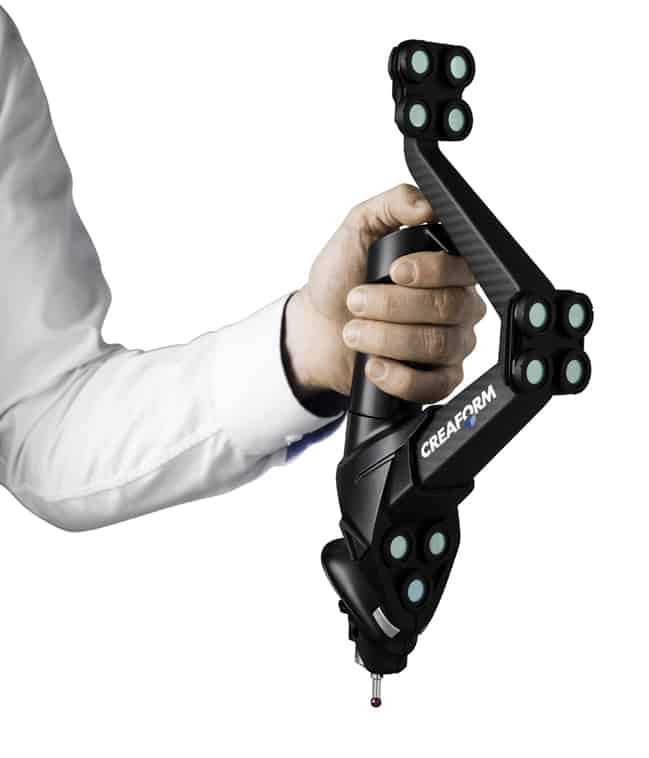Working out the final tolerance between an Airbus engine and its enclosing nacelle is no easy task. The parts include thousands of tiny, precisely designed dimensions. Up until recently, engineers would measure each individual component on coordinate measuring machine (CMM) tables. But attempting to measure the intricate design of the entire engine system on the factory floor was almost impossible.
That is, however, until portable CMMs were introduced. Engineers at Pratt & Whitney’s (P&W’s) assembly operations in Middletown, Connecticut, have been using these handheld CMMs for a number of years to drive down costs and save time. Now, it seems even more manufacturers are turning to portable CMMs to take measurements. The trend is being driven by an improvement in the technical design of the units, which now feature even better accuracy and design.
“Handheld CMMs can make it easier to measure larger parts,” said Frank Shevelow, a technician at Advance CNC Machining. “Some articulated arms, for instance, have a diameter reach of 9ft. They can also be more advantageous when there is a need to measure multiple axes at one time. They allow engineers to measure multiple aspects of a feature at one time, such as diameter and concentricity of a bore… Some software will allow you to attach devices such as a laser scanner to scan parts and compare them to a CAD model.”
At the Pratt & Whitney factory, engineers have been using CMMs known as Romer Absolute Arms from Singapore-based Hexagon Manufacturing Intelligence. “All crucial measurements can be taken while the engine remains securely within its engine build unit [EBU] on the assembly line,” explains Zvonimir Kotnik, North America portable business unit manager at Hexagon Manufacturing Intelligence.

He added: “By using the CMM to replace the expensive custom-tooled gauges traditionally used to measure large cured parts, P&W engineers anticipate saving thousands of dollars per year in tooling costs, not to mention eliminating the costs of obsolescence when part designs are changed.”
As well as being portable, handheld CMMs such as the Romer Absolute Arms have another major advantage. Engineers are able to switch from the special tube-measuring probe to a surface-measuring ball probe in a matter of seconds. This is particularly useful for tasks such as engine subassemblies, which can include a variety of different materials, such as sheet metal and tubing.
The latest generation of portable CMMs are significantly more advanced. For instance, in April, Creaform, a Canadian provider of portable 3D measurement solutions and engineering services, released its new portable CMM, dubbed the HandyProbe Next. The optical-based contact inspection solution claims to address the increasing demands of rigorous quality control directly on manufacturers’ production lines.
The HandyProbe Next features productivity and efficiency improvements in a more shop-floor-ready design for accurate part inspections, according to Creaform. It is aimed at quality-control experts who rely on portable tools to validate the size and shape of production tools, jigs, assemblies, sub-assemblies and final products. The device is claimed to be twice as accurate as similar machines.

It also uses a wireless probe that enables the instant capture of coordinates “Manufacturers are under increasing pressure to integrate more rigorous quality-control operations into their production processes, while still maintaining the same efficiency,” said Daniel Brown, senior product manager at Creaform. “The HandyProbe Next delivers versatility, shop-floor accuracy and portability, unlike articulated arms or fixed CMMs. The solution comprehensively addresses quality issues that, if left unattended, can lead to unwanted production and part approval delays, fabrication shortcomings and unexpected costs.”
Meanwhile, in February, Hexagon Manufacturing Intelligence released a new portable CMM laser scanner for large-volume inspection applications. Named the Leica Absolute Scanner LAS-20-8 portable 3D laser scanner, it is designed to make gathering complex data easier and quicker for shop-floor operators. Hexagon said the tool can be used for inspections of difficult surfaces, such as those that are shiny metallic or made from dark materials. The LAS-20-8 works for measurement volumes of up to 60m and has an IP50 rating that allows it to be taken almost anywhere in the workshop.
The scanner identifies itself to the tracker, enabling quick changes between scanning, probing and reflector measurements. A built-in guide light leads the operator to the optimum measurement position and haptic, acoustic and visual feedbacks. The laser intensity automatically adjusts to different surface types and operators can switch between pre-set measurement profiles using the main button of the scanner, so they can apply the right set-up for each section of the part without needing software adjustments.
“With the Leica Absolute Scanner LAS-20-8, we wanted to create an affordable handheld laser scanner that delivers results every time without complex set-ups or training needs,” said Duncan Redgewell, vice-president, Hexagon Manufacturing Intelligence Portable Products. “Alongside the Leica T-Scan 5 – our high-end laser scanner for feature-rich inspections or use with robotic and automated systems – LAS-20-8 enables us to offer the right laser scanning solution for any large-volume measurement application.”
Steve Young, an engineer at Exact Metrology said the biggest advantage of a portable CMM is driving down costs. “They do not require dedicated floor space or a dedicated temperature-controlled room,” he added. “They are also portable so they can be taken to the problem rather than the other way around.” He claimed that they are best suited to manufacturing engineering since they sometimes lack the right tools to solve problems on shop floor.
“A customer would, during weekend overtime hours, remove a tool from the shop floor and place it on a CMM, make all the adjustments and then reinstall it back on the shop floor, costing a lot of time and money,” he said. “Now they just go out between shifts and check the measurements on the tool with a handheld.”
Young said he believed the trend towards using handheld CMMs over more conventional table-based measurement will continue. “I think the technology will increase in accuracy in the coming years.”




Swiss geoengineering start-up targets methane removal
Several rather dubious statistics in this report. IF methane had 120× the thermal effect of CO2 that would be TWO orders of magnitude. Two is not...